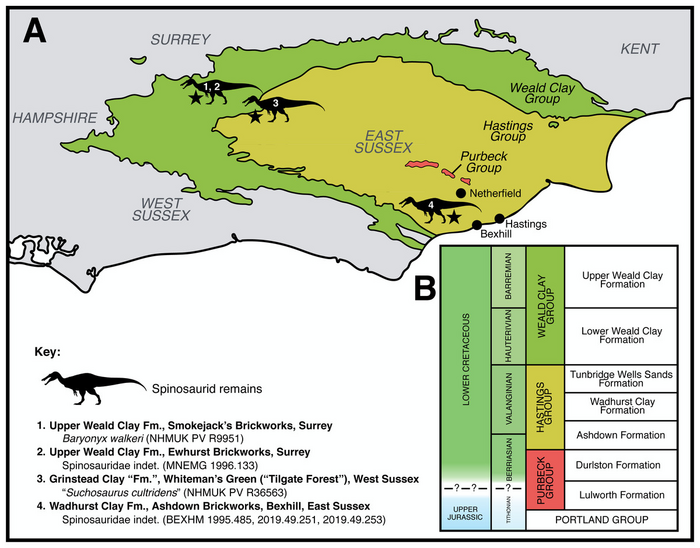Analysis of a British spinosaur tooth by palaeontologists at the EvoPalaeoLab of the University of Southampton shows that several distinct spinosaur groups inhabited Cretaceous Britain.

Credit: Spinosaurid silhouette courtesy of Dan Folkes (CC-BY 4.0).
Analysis of a British spinosaur tooth by palaeontologists at the EvoPalaeoLab of the University of Southampton shows that several distinct spinosaur groups inhabited Cretaceous Britain.
Stored within the collections of the Hastings Museum and Art Gallery in East Sussex, the fossil that forms the basis of the new study was gifted to the museum in 1889. It was collected from the local Lower Cretaceous rocks of the Wealden Supergroup, a thick, complicated rock sequence deposited across south-eastern England between 140 and 125 million years ago.
The Wealden is famous for its spinosaur fossils. Baryonyx – discovered in the Wealden of Surrey in 1983 – is one of the world’s most significant spinosaur specimens, since it was the first to reveal the true appearance of this crocodile-headed, fish-eating group. Less impressive spinosaur remains – isolated teeth – are common throughout the Wealden, and have often been identified as belonging to Baryonyx. However, some experts have long suspected that this is incorrect, and such is confirmed by the new study published in PeerJ Life & Environment.
“We used a variety of techniques to identify this specimen, in order to test whether isolated spinosaur teeth could be referred to Baryonyx”, said lead author Chris Barker, whose PhD focuses on the spinosaurs of southern Britain. “The tooth did not group with Baryonyx in any of our data runs. It must belong to a different type of spinosaur”.
The results show that distinct and distantly related spinosaur types lived in the region during Early Cretaceous times. This backs up research by the EvoPalaeoLab team, who argued in previous studies that the spinosaurs of southern England are more diverse than previously thought. In 2021, they named the ‘hell heron’ Ceratosuchops from the Isle of Wight, and in 2022 announced the discovery of what might be Europe’s largest ever land predator, a giant known only as the White Rock spinosaur. These several spinosaurs did not all live at the same time, but inhabited the region over the course of more than 15 million years.
“Museums themselves are places to make exciting discoveries as our understanding of specimens changes from the time they were deposited. What this work highlights is the importance of keeping collections alive, and developing our understanding of them. Curators are essential to help us navigate the cupboards and displays, helping us to unpick the often-incomplete records- either never fully written, or lost to time. The diversity of palaeoenvironments is not always hidden in rocks, it is often waiting in a museum, its importance waiting to be rediscovered!” – Dr. Neil Gostling
“Dinosaur teeth preserve numerous anatomical details, and we can use various analytical techniques to see how similar, or different, they are to other teeth. Our new study shows that previously unrecognised spinosaur species exist in poorly known sections of the Wealden’s history, and we hope that better remains will be discovered that improves our knowledge. Here’s another reminder that even well-studied places like southern England have the potential to yield new dinosaur species”. – Dr. Darren Naish
Journal
PeerJ
DOI
10.7717/peerj.15453
Article Publication Date
31-May-2023




